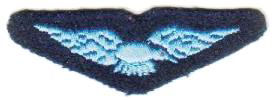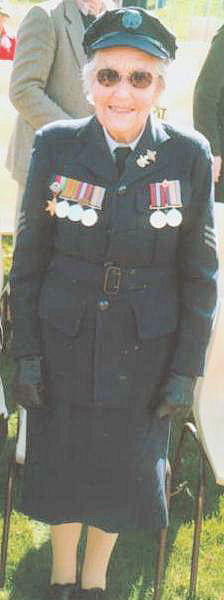WOMEN'S AUXILIARY AUSTRALIAN AIR
FORCE (WAAAF)
IN AUSTRALIA DURING WW2
![]()

Photo:- Ian Jenkins
WAAAF Cap and embroidered badge
Not long after World War 2 was declared in 1939, the Royal Australian Air Force had an urgent need for more skilled and semi-skilled signals and maintenance personnel to fulfil its wartime commitments to the Empire Air Training Scheme (EATS) for local defence in Australia. On 4 February 1941, the formation of an air force women's auxiliary was approved by the War Cabinet. It had taken 14 months of difficult discussion and opposition to achieve this final outcome.
The formation of the Women's Auxiliary Australian Air Force (WAAAF) set a precedence for the formation of other women's service organisations such as The Australian Women's Army Service (AWAS) and the Women's Royal Australian Naval Service (WRANS).
Approximately 27,000 women enlisted in the WAAAF between 15 March 1941 and 24 August 1945. In June 1941, Squadron Officer Clare Grant Stevenson was appointed Director of the WAAAF.
The first 20 WAAAFs were posted to Townsville between 28 October 1941 and 7 February 1942 to work at the North-Eastern Area Headquarters in Sturt Street. They were urgently required to fill the roles of teleprinter operators and general clerks. This initial intake of WAAAFs in the area were living in various homes or flats in Townsville. The Officer-in-Charge of WAAAFs in the Townsville area, Assistant Section Officer Yvonne Rentoul established the new WAAAF Barracks in St Anne's Church of England School in Townsville. It was a difficult task as Townsville was rapidly filling with American and Australian military units. This influx lead to a shortage of equipment and a demanding role in protecting the well-being of the fresh new female recruits.

Photo:- Ian Jenkins
'Red-Eye'd Shoulder Eagle'
"...Seniority of service
was prized by every early WAAAF, and 1941/early
1942 girls had a red eye shown on the eagle on the arm, the later 1942 girls
hadn't. Cutting words were exchanged on our unit when it was discovered
that some cheating WAAAF were actually sewing the red eye in".
(The WAAAF Book, Stevenson
and Darling, P.110, 'The well dressed WAAAF')
| WAAAF Ranks | RAAF Equivalent Ranks |
| Commandant-in-Chief | Air Marshal or above |
| Air Chief Commandant | Air Vice Marshal |
| Air Commandant | Air Commodore |
| Group Officer | Group Captain |
| Wing Officer | Wing Commander |
| Squadron Officer | Squadron Leader |
| Flight Officer | Flight Lieutenant |
| Section Officer | Flying Officer |
| Assistant Section | Officer Pilot Officer |
| Under Officer | Warrant Officer |
| Flight Sergeant | Flight Sergeant |
| Sergeant | Sergeant |
| Corporal | Corporal |
| Leading Aircraftwoman | Leading Aircraftman |
| Aircraftwoman | Aircraftman |

Photo:- Ian Jenkins
'One of the Originals' - WAAAF
Sgt. Dorothea Watson (Andrews)
in her original uniform at the 60-year Commemoration of VP Day
celebrations at the Australian War Memorial in August 2005.
Royal Australian Air Force
Commonwealth War Graves and Memorials
In Australia 1939 - 1945
There are a total of 2,372 Royal
Australian Air Force personnel
including W.A.A.A.F.s buried in War Cemeteries or public & private
cemeteries or listed on various Memorials around Australia in the
calendar years 1939 to 1945. A high percentage of these would
have died in military aircraft crashes in Australia
during WWII.
ACKNOWLEDGEMENTS
I'd like to thank Ian Jenkins for his assistance with this web page.
REFERENCE BOOKS
"The WAAAF in Wartime
Australia"
by Joyce Thomson
"The WAAAF Book"
Edited by Clare Stevenson and Honor Darling
Can anyone help me with more information?
"Australia @ War" WWII Research Products
|
© Peter Dunn 2015 |
Please
e-mail me |
This page first produced 15 June 2002
This page last updated 15 January 2020